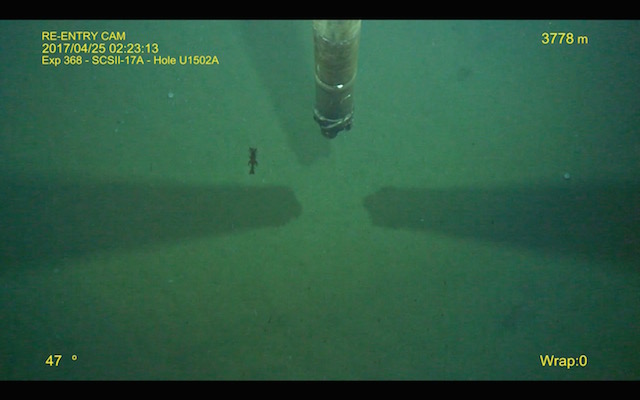
Evidence is your anchor out at sea!
The potential for new discoveries on JOIDES Resolution is great. Like space, the ocean floor and below are a relatively new frontier.
The last few days on the ship have been focused on what the first cores from hole 1 can tell us about the bigger picture of what has happened in the South China Sea Rifted Margin. The scientists have been tirelessly analyzing data from the cores and now it is time to write. This is a very focused period as the scientists are preparing their reports and writing up their claims about what they have identified and what this microfossil or that mineral can tell us about the time period, climate, seal level, or mechanism of formation of these layers of sediment and rock. Where there is an abundance of evidence the scientists will make confident claims. But if they are not sure, if they can not explain a certain trend in the data, if there is something unexpected, or possibly something that has never been seen before in a layer how do they approach it?
The allure of being the first one to discover something is enticing. Imagine how great it would be to go down in history as the first person to identify joideserezilutionite (totally made up mineral)! Could this anomaly in my data be a new discovery? “Eureka! I found it!” Well, not quite. Before you go telling the press, what precautions would you take to make sure what you are seeing is truly a discovery and not just an error?
To get a picture of the thinking process scientists go through when they are finding unexpected results I asked a few scientists on board Expedition 368 – What is the first thing you do when you find strange and unexpected data? How would you confirm or rule out a new discovery. Here are their answers in summary.
Find corroborating evidence. Ask yourself does it fit? If not make a measured claim. Take a minute to step back and evaluate the evidence. Sleep on it.
Revisit your background research. Know what to expect so that you can detect anomalies. Make sure that there is strong evidence. Double check and confirm that the data is strong and believable. Develop more questions and see if the explanations make sense. In geology a common question is – How did it get there? Does it fit in to the current explanation or does it change everything? The more it changes things the stronger the evidence you need.
1st step is to talk with colleagues. Try to come to consensus agree on other tests that would help confirm the results.
RECORD YOUR OBSERVATIONS – do more background research and see if someone else has found this and what their opinion is. Talk to colleagues. Design a new test and a research plan. Complete a literature review.
Talk with other people, review the literature. Remeasure. Check standards that you use for calibration, they could be wrong.
Rule out mistakes by repeated measuring. Cry. When in doubt report a tempered response… “this could possibly be_____ however further research is needed…etc.”
When making a claim about a new discovery there is a risk, you could be wrong, or worse you could be second. On one hand there is a great fear of embarrassment if you misinterpret your data on the other if someone else publishes before you all of your hard work is lost. So these imposing pressures create something of a slow motion race for scientists where before they can move forward with a novel explanation of the natural world they must be sure that their evidence is anchored firmly, accurately, and that human and mechanical error is reduced.
Eric, Ferre, a Paleomagnetist on board, coaches his graduate students to be cautious and to double check their data and interpretations of it. He likened the process to lead climbing when rock climbing. Lead climbing is where you must set your own rope as you climb up the rock face with anchors. These anchors in science are your evidence. You need to make sure it is strong and also you need to set and check your anchor very well and often as you climb. You might not climb as fast but with strong anchors that are well set if you fall, which happens to all scientists and climbers at some point, you might get bumped and bruised but you will still be in the game.